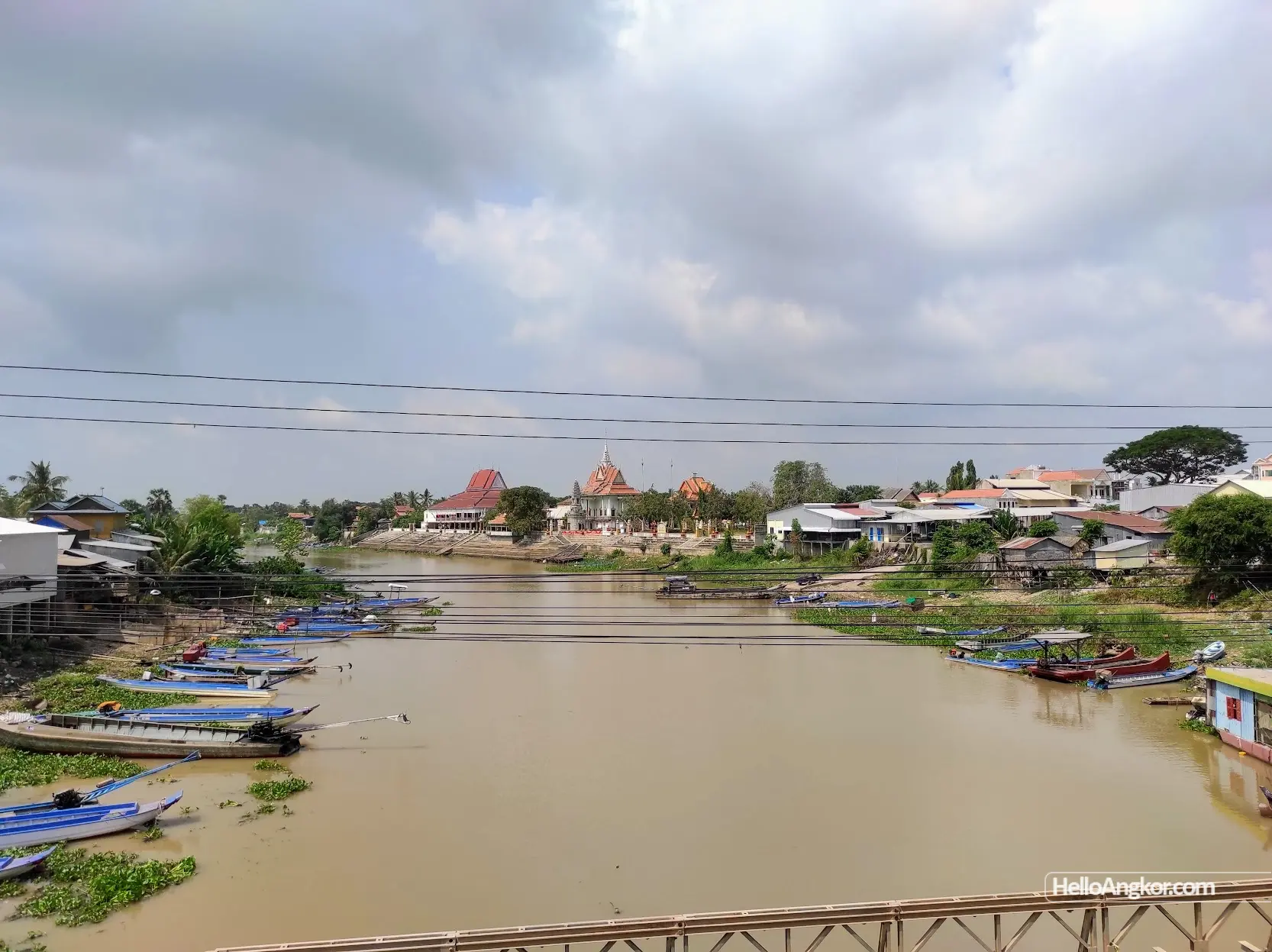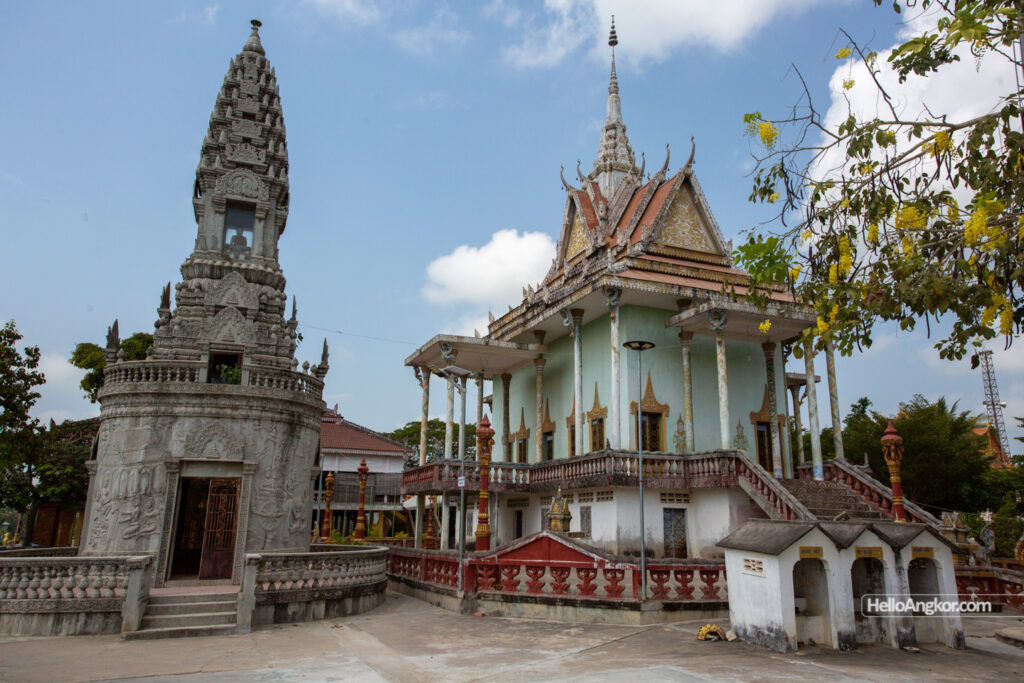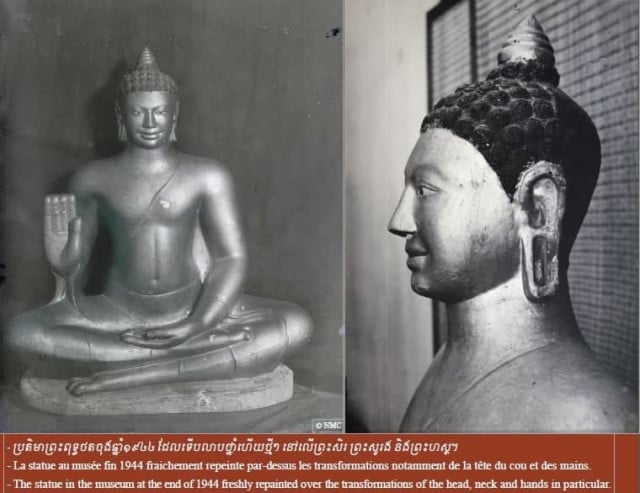វត្តកំពង់ហ្លួង Wat Kampong Luong
[googlemaps https://www.google.com/maps/embed?pb=!1m18!1m12!1m3!1d6586.896033133857!2d104.97160165994724!3d10.994151132369069!2m3!1f0!2f0!3f0!3m2!1i1024!2i768!4f13.1!3m3!1m2!1s0x31097f0df866e763%3A0xc7821465f152516f!2sKampong%20Luong%20Pagoda!5e0!3m2!1svi!2ssg!4v1722840412545!5m2!1svi!2ssg&w=600&h=450]Wat Kampong Luong (Angkor Borei)

- Area: Ta Keo Province > Angkor Borei District > Angkor Borei Commune > Kâmpong Luong Village
- | Type: Ancient Remains & Temples
Contemporary monastery and pagoda located on the river bank of Angkor Borei.



A seated Buddha statue was removed from the pagoda here and now resides in the Phnom Penh National Museum. According to Nancy Dowling’s study, the statue likely dates to 660-665 AD. The statue was lacquered which, researchers discovered had taken place in four coating phases taking place between the 14th and 19th century, with a synthetic coating in recent times (LY 2021).
Site Info
- Site Name: Kampong Luong (V.) Khmer Name: វត្តកំពង់ហ្លួង
- Reference ID: HA11942 | Posted: December 28, 2021 | Last Update: April 5th, 2024
- Other Names: Wat Kompong Luang
- Tags/Group: Angkor Borei, T23, T4, Temples, Wat
- Location: Ta Keo Province > Angkor Borei District > Angkor Borei Commune > Kâmpong Luong Village
- MoCFA ID: 659
- IK Number: 17
Rodney Charles LHuillier
Living in Asia for over a decade and now residing in beautiful Siem Reap – Contact via rod@helloangkor.com – more..
https://www.kasey-hamilton.com/buddha-from-vat-kampong-luong.html
Buddha from Vat Kampong Loung: Background and materials analysis
The final appearance, shown in the image above, reveals the sandstone, still covered in places with a dark coating, presumably lacquer. Remnants of red and gold were also visible throughout. At the back of the proper right thigh a large square patch remains, where some gold and red layers were intentionally preserved.
During treatment, conservators at the museum attempted to characterize the stratigraphy of paint layers and the repair materials using visual identification supplemented with knowledge of traditional methods. Layers of polychromy were classified as gold synthetic paint, gold leaf, red lacquer, and black lacquer. The lacquers are likely of vegetal origin, colored with added pigments, although their exact composition was unknown. The repair mortar was thought to be created from a mixture of ground mussel shells, palm juice and rice starch.
During my internship at the National Museum, I sampled areas of polychromy from repair elements, remaining lacquer on the stone sculpture itself, and the repair mortar. I brought these samples back to UCLA, and analyzed them using SEM/EDS, μ-Raman spectroscopy, and ATR-FTIR in order to obtain a better understanding of the materials present. Cinnabar was identified as the red pigment present in red lacquer layers both on the surface of the stone, as well as repair elements. No added pigment included within the black lacquer layers. The repair mortar was found to contain crushed rock fragments, quartz, fragments of diatoms (possibly from diatomaceous earth), and rice starch. Collaboration with scientists at the Getty Conservation Institute allowed for analysis of lacquer layers using pyrolysis gas chromatography-mass spectrometry. Both red and black lacquers were found to be thitsi lacquers, however differences in composition were observed between various lacquering campaigns and colors (red vs black). This is likely due to the presence of different additives mixed in with the lacquer. Further research and comparison to historical Cambodian lacquering practices may aid in dating the application of the lacquer layers.





Wat Kompong Luong Buddha
https://cambodianess.com/article/vat-kompong-luong-buddha

Photo provided by the National Museum of Cambodia
- Cambodianess
- April 15, 2021 8:51 AM
PHNOM PENH–The National Museum of Cambodia in collaboration with the École française d’Extrême-Orient (EFEO), or French school of Asian studies, has been holding its first virtual exhibition to commemorate the 100th anniversary of the museum. During the exhibition period, some sculptures and their histories are to be displayed digitally. With the approval from the National Museum of Cambodia, and in contribution to the promotion of Khmer cultural heritage, Cambodianess is pleased to present an overview on “Vat Kompong Luong Buddha.”
This statue of the Buddha looked very different when it was still on the altar of the vihear of Wat Kompong Luong (in the ancient city of Angkor Borei). Doubtless carved in the 6th century and revered appar- ently without interruption since it had been restored and covered with several layers of lacquer and gilding applied over the centuries. The last “restoration”, probably dating back to the 19th century, had considerably modified its appearance, notably by lengthening the neck and remodel- ing several other features.
In September 1944, with the support of King NORODOM SIHANOUK, Pierre Dupont, then director of the museum, decided to transfer the statue to the museum with the intention of restoring its original appearance. Mr. Kam Doum, secretary of the museum, who was in charge of the mission, had great difficulty convincing the chief of the pagoda and the local population of the importance of letting it go. It was only after long negotiations that the statue, traveling up the Bassac by boat, arrived in Phnom Penh, together with a load of other artworks for the museum. During the transfer, the statue broke in two across the abdomen. Very embarrassed, Pierre Dupont was obliged to abandon his plan to remove all the other paintings: in order to conceal the repair, he end- ed-up doing the reverse: repainting the entire statue in gold.
In the early 2000s, when very tarnished paint was peeling, a long and delicate “de-restoration” was undertaken. This operation aimed to preserve only the remains of fifteen-century black and red plaster that did not modify the original modeling. Saved from destruction at the hands of the Khmer Rouge thanks to its transfer, the statue has now reassumed its original contours.
In particular, we may observe that the Buddha’s face is similar to those of the Vishnu sculptures of Phnom Da, a site neighboring Angkor Borei (these are exhibited a little further on, in the center of the gallery). Indeed the Wat Kompong Luong Buddha may be the work of the same sculptors as those who fashioned the Phnom Da images.
Text provided by the National Museum of Cambodia
